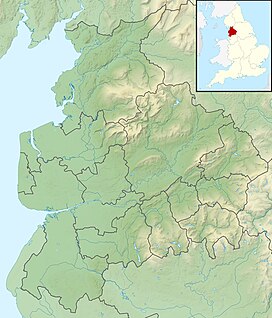
Bolton is a town in Greater Manchester in England. In the foothills of the West Pennine Moors, Bolton is between Manchester, Blackburn, Wigan, Bury and Salford. It is surrounded by several towns and villages that form the wider borough, of which Bolton is the administrative centre. The town is also within the historic county boundaries of Lancashire.

Kinder Scout is a moorland plateau and National Nature Reserve in the Dark Peak of the Derbyshire Peak District in England. Part of the moor, at 636 metres (2,087 ft) above sea level, is the highest point in the Peak District, in Derbyshire and the East Midlands.

Parlick is an approximately cone-shaped steep-sided hill at the extreme south of the main range of Bowland fells in Lancashire, England. Its bog-free sides make it more popular with walkers than the shallow boggy hills to its north. Paths zigzag up this hill from the south, or for the more strenuous ascent a straight path can be chosen. This hill is usually green — different from the often thorny brown to red of the northern hills. A thin neck joins Parlick onto Fair Snape Fell with well-worn paths linking the two.

Horwich is a town and civil parish in the Metropolitan Borough of Bolton, Greater Manchester, England, within the historic county boundaries of Lancashire. It is 5.3 miles (8.5 km) southeast of Chorley, 5.8 miles (9.3 km) northwest of Bolton and 15 miles (24 km) northwest of Manchester. It lies at the southern edge of the West Pennine Moors with the M61 motorway passing close to the south and west. At the 2011 Census, Horwich had a population of 20,067.
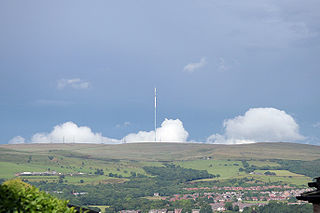
Winter Hill is a hill on which the three boroughs of Chorley, Blackburn with Darwen and Bolton meet in North West England. It is located on Rivington Moor, Chorley and is 1,496 feet (456 m) high. Part of the West Pennine Moors, it is a popular walking area, and has been the site of mining activity, aeroplane disasters and murders.

Anglezarke is a sparsely populated civil parish in the Borough of Chorley in Lancashire, England. It is an agricultural area used for sheep farming and is also the site of reservoirs that were built to supply water to Liverpool. The area has a large expanse of moorland with many public footpaths and bridleways. The area is popular with walkers and tourists; it lies in the West Pennine Moors in Lancashire, sandwiched between the moors of Withnell and Rivington, and is close to the towns of Chorley, Horwich and Darwen. At the 2001 census it had a population of 23, but at the 2011 census the population was included within Heapey civil parish. The area was subjected to depopulation after the reservoirs were built.
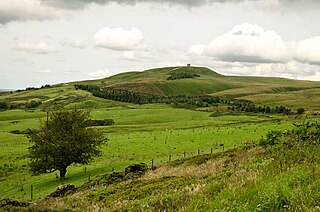
Rivington is a village and civil parish of the Borough of Chorley, Lancashire, England, occupying 2,538 acres. It is about 6 miles (9.7 km) southeast of Chorley and about 8+1⁄2 miles (13.7 km) northwest of Bolton. Rivington is a rural area consisting primarily of agricultural grazing land, moorland, with hill summits including Rivington Pike and Winter Hill within the West Pennine Moors. The area has a thriving tourist industry centred around reservoirs created to serve Liverpool in the Victorian era and Lever Park created as a public park by William Lever at the turn of the 20th century, with two converted barns, a replica of Liverpool Castle and open countryside. Rivington and Blackrod High School is located here. Rivington and its village had a population of 109 at the 2011 Census.

Smithills Hall is a Grade I listed manor house, and a scheduled monument in Smithills, Bolton, Greater Manchester, England. It stands on the slopes of the West Pennine Moors above Bolton at a height of 500 feet (150 m), 3 miles (4.8 km) north west of the town centre. It occupies a defensive site near the Astley and Raveden Brooks. One of the oldest manor houses in North West England, its oldest parts, including the great hall, date from the 15th century and it has since been altered and extended, particularly the west wing. Parts of it were moated. The property is owned by Bolton Metropolitan Borough Council and open to the public.

The West Pennine Moors is an area of the Pennines covering approximately 90 square miles (230 km2) of moorland and reservoirs in Lancashire and Greater Manchester, England. It is a Site of Special Scientific Interest.
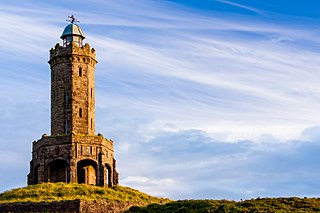
The octagonal Jubilee Tower at grid reference SD678215 on Darwen Hill overlooking the town of Darwen in Lancashire, England, was completed in 1898 to commemorate the Diamond Jubilee of Queen Victoria, while also celebrating the victory of the local people for the right to access the moor. It was opened to the public on 24 September 1898. The architect was R. W. Smith-Saville and he modified the plans for the tower slightly.

Great Hill is a hill in Lancashire, England, on Anglezarke Moor, between the towns of Chorley and Darwen. It is part of the West Pennine Moors and lies approximately 3 miles north of Winter Hill, which is the highest point in the area at 456 m (1,498 ft).

Baugh Fell is a large, flat-topped hill in the northern Pennines of England. It lies in the north-western corner of the Yorkshire Dales National Park, immediately to the east of the Howgill Fells and to the north of Whernside, the highest of the Yorkshire Three Peaks. Formerly in the West Riding of Yorkshire, since 1974 it has been part of the county of Cumbria.

Heath Charnock is a small village and civil parish of the Borough of Chorley in Lancashire, England. According to the United Kingdom Census 2001 it has a population of 2,065, reducing to 2,026 at the 2011 Census.

Rivington and Blackrod High School in the North West region of England is a Leverhulme Trust multi-academy comprehensive school. Alongside Harper Green School, it operates as a Church of England teaching environment with a sixth form school. The school is located at two sites, with the upper school situated on Rivington Lane in Rivington, Lancashire, and the lower school situated on Albert Street in Horwich, Greater Manchester.

Rivington in the Borough of Chorley, Lancashire, is situated on the edge of the West Pennine Moors, at the foot of Rivington Pike overlooking reservoirs created for Liverpool Corporation Waterworks in the 19th century. There are twenty eight listed buildings within Rivington, two are classified by English Heritage as Grade II*, the rest as Grade II; Rivington has no Grade I Listed buildings.

Healey Nab or "The Nab" is an area of countryside owned partly by Lancashire County Council containing rolling hills, moorland, woodland, ponds and streams to the east of Chorley, Lancashire, between the M61 and the West Pennine Moors. To its southeast is Anglezarke Reservoir and to its northeast is White Coppice.
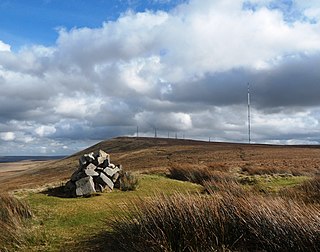
Noon Hill is a hill on the border of the boroughs of Chorley, Blackburn with Darwen and Bolton, in North West England. It is located on Rivington Moor, Chorley and is 380 metres (1,247 ft) high. Part of the West Pennine Moors, it is a popular walking area, and is of significant historical interest. The summit of Noon Hill is home to a Bronze Age burial mound which is listed under the Ancient Monuments and Archaeological Areas Act 1979 as it appears to the Secretary of State to be of national importance.
Rivington Heritage Trust, an arm of United Utilities was formed 1997, is a vehicle created to obtain charitable funding for United Utilities to enable the PLC to reduce costs of its statutory obligations to upkeep and maintain its Rivington property. Previously known as the United Utilities Heritage Foundation, it aims to preserve the Terraced Gardens at Rivington, Lancashire, England and is incorporated with charitable aims to "To consult with stakeholders on the use and development of Rivington Terraced Gardens for the benefit of the public and the environment." The objects are to conserve, preserve, maintain, protect and enhance for the benefit of the public land and structures of outstanding natural beauty or of historic or architecture", its headquarters have remained the United Utilities Head Office at Warrington, the freeholder of land it manages.

Terraced Gardens of Rivington is a landscaped woodland on the hillside of Rivington Pike, in Rivington Parish in the Chorley Borough of Lancashire, England, originally designed as a Garden by T.H. Mawson and built as curtilage to a home of the soap magnate Viscount Leverhulme; as such, the area is not part of Lever Park. The gardens contains and abuts the SSSI of the West Pennine Moors. Today the former gardens are Grade II listed and contain eleven Grade II structures. The original design had three elements — the upper part being in the romanesque architectural style, the lower section, known as the Ravine, was a woodland with a man-made stream, and a Japanese-style garden, with a man-made pond constructed of Pulmonite which remains today. The gardens are leased to Rivington Heritage Trust by United Utilities and are undergoing restoration and preservation.

